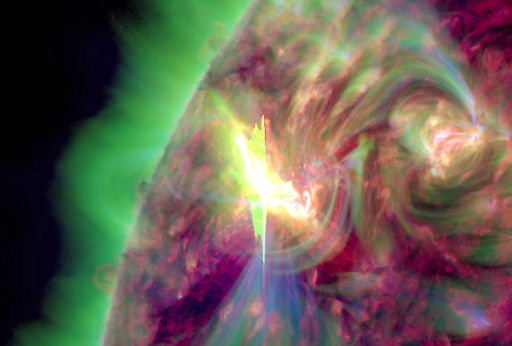CLOSE ENCOUNTER WITH MARS: Today, Mars is at its closest to Earth for 2012. The Red Planet is only 101 million km away and shines about six times brighter than a 1st magnitude star. Look for it in the eastern sky at sunset. The burnt-orange color of Mars is very distinctive, especially when seen from rural areas with clear skies. [sky map] [images: #1, #2, #3]
STRONG SOLAR ACTIVITY: Solar activity is now high. Big sunspot AR1429, which emerged on March 2nd, is crackling with strong flares. This morning brought the strongest so far--an X1-class eruption on March 5th at 0413 UT. NASA's Solar Dynamics Observatory recorded the extreme ultraviolet flash:
Update: The explosion also hurled a bright CME into space. According to analysts at the Goddard Space Weather Lab, the CME will probably miss Earth, although it will hit Mercury and Venus. An animated forecast track shows the likely progression of the cloud.
Even if this CME misses, high-latitude sky watchers should still be alert for auroras in the nights ahead. An M2-class eruption from the same sunspot on March 4th produced another, wider CME that might yet intersect Earth. The cloud is expected to deliver a glancing blow to our planet's magnetic field on March 6th at 04:30 UT (+/- 7 hr). Auroras alerts: text, phone.

Solar wind
speed: 367.9 km/sec
density: 3.5 protons/cm3
explanation | more data
Updated: Today at 1535 UT
X-ray Solar Flares
6-hr max: C5 1213 UT Mar05
24-hr: X1 0410 UT Mar05
explanation | more data
Updated: Today at: 1500 UT
![]()
Daily Sun: 05 Mar 12
Big sunspot 1429 poses a threat for X-class solar flares. Credit: SDO/HMI
![]()
Sunspot number: 70
What is the sunspot number?
Updated 04 Mar 2012
Spotless Days
Current Stretch: 0 days
2012 total: 0 days (0%)
2011 total: 2 days (<1%)
2010 total: 51 days (14%)
2009 total: 260 days (71%)
Since 2004: 821 days
Typical Solar Min: 486 days
Updated 04 Mar 2012
The Radio Sun
10.7 cm flux: 120 sfu
explanation | more data
Updated 04 Mar 2012
![]()
Current Auroral Oval:
Switch to: Europe, USA, New Zealand, Antarctica
Credit: NOAA/POES
![]()
Planetary K-index
Now: Kp= 1 quiet
24-hr max: Kp= 3 quiet
explanation | more data
Interplanetary Mag. Field
Btotal: 6.1 nT
Bz: 5.6 nT south
explanation | more data
Updated: Today at 1536 UT
![]()
Coronal Holes: 05 Mar 12
A solar wind stream flowing from this coronal hole could reach Earth on March 8-9. Credit: SDO/AIA. ![]()




